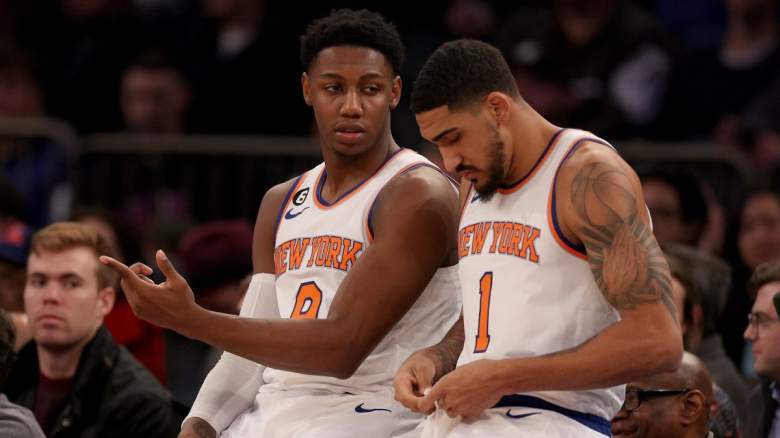
Getty RJ Barrett and Obi Toppin of the New York Knicks wait to be subbed in the game in the first quarter against the Indiana Pacers.
Obi Toppin is the only natural power forward left in the New York Knicks lineup after Julius Randle went down with a sprained left ankle.
Yet he wasn’t part of Tom Thibodeau’s closing lineup in a 101-92 win over the Miami Heat last Wednesday.
It was a sprinkle of Josh Hart at the onset of the fourth quarter and a heavy dose of RJ Barrett down the stretch to match the Heat’s small ball with Jimmy Butler playing power forward.
“I’ve done it before. I’m comfortable with it,” Barrett said during his postgame locker room interview. “With the way the NBA is now, it makes it kind of easier, especially [against] a team like Miami.”
Barrett helped limit Butler, the Heat’s leader, to just two points on two attempts in the decisive fourth quarter. On the offensive end, Barrett found his rhythm, scoring five points on 2 of 3 shots.
Barrett ended up with 12 points on 5 of 13 shooting after missing his first eight attempts in the opening half.
Focus shifts on Barett, with Randle out for the remainder of the regular season. The Knicks need him to step up to cruise to the playoffs without a hitch in Randle’s absence.
Knicks’ Forgotten Man
Thibodeau hinted at Toppin and Hart and third-string center Jericho Sims as potential fillers for Randle, who will miss at least the next two weeks with his ankle injury.
“We have a lot of confidence in Obi (Toppin). We have a lot of confidence in Josh Hart at the four. We know Jericho (Sims) can play the four as well,” Thibodeau said. “So it’s different, but it’s still very effective.”
Barrett had become an afterthought since Jalen Brunson’s arrival and even more when the Knicks acquired Hart at the trade deadline.
Once the No. 2 option behind Randle, Barrett has slid to No. 3 and even to No. 4 with Brunson and Immanuel Quickley’s rise. And when Hart came on board, Thibodeau rarely fielded Barrett in the closing lineup until Wednesday’s win against the Heat.
Barrett has plateaued this season after signing a four-year extension which could be worth up to $120 million last summer.
His numbers — 19.6 points, 5.0 rebounds and 2.7 assists — are down, and so is his 3-point shooting percentage (31.8%). What’s keeping him afloat is his improved accuracy inside the arc. He’s sinking 49.3% of his 2-point attempts.
Thibodeau has tried to stagger Barrett’s minutes with Randle and Brunson, often playing the 22-year-old wing with the bench to get his rhythm.
It clicked last Wednesday night against the Heat.
How Can Knicks Optimize Barrett as Power Forward
Barrett deflected the question to the coaching staff when asked if he sees himself stepping into the role again against the Cleveland Cavaliers on Friday night.
Barrett, whose barreling ways to the rim are his strongest suit, is most effective as a power forward when paired with a center who does not clog the paint.
According to Cleaning The Glass, the Knicks have a positive net rating when Barrett plays with either Randle or Isiah Hartenstein as the center. But when flanked with starting center Mitchell Robinson, who does not possess a perimeter game, a Knicks lineup with Barrett as a power forward has a negative net rating.
Will Barrett finally be able to find his footing?